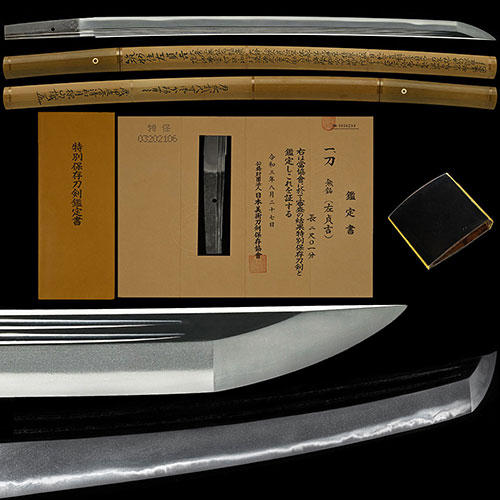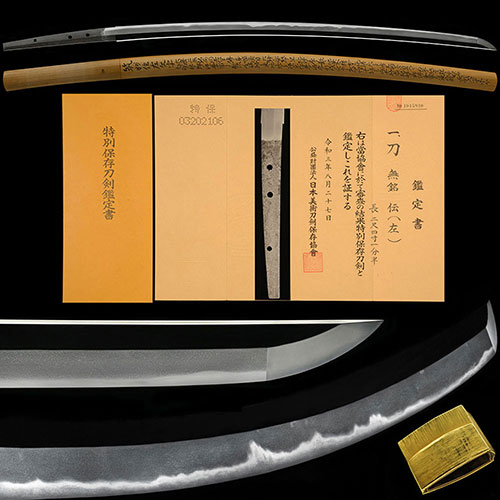
左貞吉 刀 Sa Sadakichi Katana
No.016361左貞吉 大左子 地景を細かに織り成して黒く冴えた鍛に金筋沸筋掛る覇気溢れる名品 二尺一分Sa Sadakichi Ohsa child Chikei entered finely A masterpiece full of ambition with Kinsuji and Niesuji-kakaru black clear Kitae 61.6cm
ご成約Sold
関連商品
- 極めKiwame
- 左貞吉Sa Sadayoshi
- 登録証Registration
- 東京都 Tokyo 昭和54年4月26日 4/26/54(Showa)
- 時代Period
- 南北朝時代前期Early Nanbokucho period
- 法量Size
-
刃長 61.6cm (二尺一分) 反り 0.5cm
元幅 3.2cm 先幅 2.7cm 元重 0.57cm 鎬厚 0.61cm 先重 0.51cm 鋒長 6.0cm 茎長 13.8cm 重量 616gHachou 61.6cm (二尺一分) Sori 0.5cm
Moto-Haba 3.2cm Saki-Haba 2.7cm Moto-Kasane 0.57cm Shinogi-Thikess 0.61cm Saki-Kasane 0.51cm Kissaki-Chou 6.0cm Nakago-Chou 13.8cm Weight 616g - 国Country
- 筑前Chikuzen
- 姿Shape
- 鎬造、庵棟、身幅広く、先幅広く、重ね薄く、反り浅く、大鋒。Shinogidukuri, Iorimune, Wide Mihaba , Wide Sakihaba, Thin Kasane, Shallow Sori, Oh-Kissaki.
- 鍛Kitae
- 小板目肌つみ、杢目肌に小杢目肌交じり、地沸微塵に厚くつき、地景よく入り、鉄冴える。Small-Itamehada-tsumi, Mixed Small Mokumehada and Mokumehada, Jinie entered fine and thick, Chikei entered well, Iron is clear.
- 刃文Hamon
- 浅くのたれて、互の目に、小互の目・丁子刃など交じり、湯走り・飛び焼き・二十刃頻りに掛かり、足よく入り、沸深くよくつき、金筋・沸筋・砂流し掛り、匂口明るく冴える。Shallow Notare, Gnome, Small-Gunome, Mixed Choujiba, Yubashiri, Tobiyaki, Nijuba-shikirinikakari, There are many Ashi, Deep Nie entered well, Kinsuji, Niesuji and Sunagashi-kakari, Nioikuchi is bright and clear.
- 帽子Boushi
- 乱れ込んで先尖って返る。Midarekonde-Sakitogatte-kaeru
- 茎Nakago
- 茎は、大磨上、先切、鑢目切、目釘孔一。Nakago is Ohsuriage, Sakikiri, Yasurimegiri, Mekugiana is one(1).
- ハバキHabaki
- 赤銅金色絵一重。Syakudou Kiniroe single (Single layer of shakudo gilt painting.)
- 説明Drscription
- 筑前国左文字は、大左と通称され、実阿の子と伝え、銘文の左は、左衛門三郎の略という。相州正宗十哲の一人に数えられ、それまでの古典的な九州物の作域から大いに脱皮し、地刃共に明るく冴え、地景や金筋の目立つ新作風を確立した。現存する在銘の太刀は、国宝の「江雪左文字」のみであるが、短刀の作例は比較的多く残されている。左一門は、南北朝期に大いに栄えたが、大左の子と伝える貞吉・安吉を始め弘行・国弘などがいて、これら左一門を末左と呼称する。貞吉は、大左の子で、南北朝時代文和元年の年紀作がある。この刀は、体配から元は三尺程の大太刀であったと思われ、身幅広く、鋒延びる南北朝の姿で、地景を細かに織り成して黒く冴えた鍛に、直刃を基調にのたれごころをおび、小互の目や丁子等が交じり、ほつれかかり、湯走り・飛び焼き・二十刃頻りに掛り、足よく入り、沸深くつき、金筋・沸筋・砂流しかかるなど、左の特色を窺わせる作域を表しており、元のほうが直刃基調の穏やかな出来から貞吉に極められたものと思われるが、頗る健全で覇気溢れ、風格ある左の名品である。Chikuzennokuni Samonji is commonly known as Ohsa and is said to be a child of Jitsua, and the inscription Sa is an abbreviation for Saemon saburou. He was one of Sousyu Masamunejittetsu, and he was a big break from the classic Kyusyu production area, and he was bright and clear with Jiba, establishing a prominent new style of Chikei and Kinsuji. The only existing Tachi in existence is the national treasure "Kousestsu Samonji", but there are relatively many examples of Tantou.
The Sa clan flourished during the period of the Northern and Southern Courts, and included Sadayoshi and Yasukichi, who are said to be children of Ohsa, as well as Hiroyuki and Kunihiro, and these Sa clan are called Suesa.
Sadakichi was the son of Ohsa, and there is a historical work written in the 1st year of Bunna during the Nanbokucho period.
Judging from the shape of this sword, it is believe that is was originally Ohdachi of about 61.6cm, wide Mihaba, In the form of Nanbokucho that extends Kissaki, Chikei is woven finely into a black and clear Kitae. Based on Suguha, with Notare-gokoro, Mixed small-genome and Chouji, Hotsurekakari, Yubashiri, Tobiyaki, Nijuba-shikirinikakari, There are many Ashi, Deep Nie entered, Kinsuji, Niesuji and Sunagashi-kakaru, It represents a production area that shows the characteristics of Sa. The original one seems to have been perfected by Sadayoshi due to its gentle Suguha-based tone. It is a masterpiece of Sa, which is extremely Kenzen, full of ambition, and dignified.



